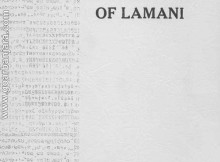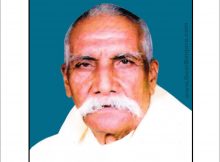A Grammar of Lamani (Banjara)
Written by : Ronald L. Trail
A thesis submitted to the University of Poona for the degree of Doctor
of Philosophy in Linguistics, 1968
THE GRAMMAR OF LAMANI Introduction. The Lamani language belongs t o the Indo-Aryan family of languages. It originated in Rajasthan and i n the opinion of the author, descended from Old Western Rajasthani along with Gujarati and Marwadi. The people claim descendancy from the Rajputs. They are known by several names such as: Banjari, Wanjari, Labhani, Lambani, Lambadi, Sukali and Singadi. The people prefer to c a l l themselves Gormati or Gorwa t . A t the present time the people, being nomadic, are s c a t t e r e d throughout Central India with heaviest population concentrations i n Maharashtra, Mysore, and Andhra Pradesh. According t o the ‘ 6 1 Census, Lamani is now spoken by over one million people. The d i a l e c t here described is spoken in the Gulbarga D i s t r i c t of northern Mysore State–the area from which the Lamanis living next t o Deccan College, Poona, have migrated. However, samples of t e x t of the d i a l e c t s spoken i n Andhra near Hyderabad and in the Guntur D i s t r i c t of Andhra have a l s o been included in the analysis . The Lamani language, although varying somewhat in vocabulary and phonemic inventory from area t o area, has v i r t u a l l y the same s y n t a c t i c s t r u c t u r e throughout. There is one exception t o t h i s v i z . , the Mathuri Banjari, spoken i n Yeotmal D i s t r i c t of Mahar a s h t r a , which is said t o be a separate d i a l e c t . Not much work has been done previously on Lamani. Only two works have come t o my notice. One is i n Sir George Grierson’s L i n g u i s t i c Survey of I n d i a . I n it he gives some very brief grammatical notes, some t e x t and comments on its origin. The other is an a r t i c l e e n t i t l e d , “Lambani Jana Mattu Avara Bhase”, by M. Chidananda Murty in the journal Prabuddhakarnataka. It is written i n Kannada and is largely ethnological i n character with comments on the vocabulary, but l i t t l e d e t a i l e d grammatical analysis. In the course of t h i s t h e s i s I have had several informants. Naik Desu Chandu Chawan, Motilal Kissan Chawan and Hiralal Topaji Chawan were the main three. Naik Desu Chandu Chawan, however, is the one who gave me my s t a r t in Lamani, and the one t o whom I s t i l l go for checking. He is the chief of one of the two Lamani v i l l a g e s next t o Deccan College. Because of a bad f a l l several years ago which l e f t him p a r t i – a l l y paralyzed, he is unable t o do manual work. H i s age is about 60 years. A common concept t h a t we have encountered about Lamani among laymen is t h a t it is not a language in its own r i g h t , but a mixture of Marathi, Gu j a r a t i and Hindi. Having spent considerable time analyzing it we must say something t o counter t h i s view. Lamani is a language in its own r i g h t . It has an i n t r i c a t e s t r u c t u r e which is d i s t i n c t from and yet similar t o t h e t h r e e languages mentioned above and t o a l l other Indo-Aryan languages. Taqrnemic theory as conceived by Kenneth L. Pike i n h i s ~anguage-in elation- t o a Unified he or^ of t h e S t r u c t u r e of f mar Discovery Procedures, provides t h e d e s c r i p t i v e m o d e l o r t h i s t h e s i s . Tagmemics views language as “structured i n three semiautonomous but interlocking modes, phonology, grammar and lexicon”, Longacre 1964 p. 7. Each of these modes has its own hierarchy building from small, r e l a t i v e l y simple u n i t s i n t o large, more complex units. Phonology begins with the phoneme as its smallest u n i t and builds i n t o s y l l a b l e s ; syll a b l e s build i n t o rhythm u n i t s ; rhythm u n i t s i n t o s t r e s s groups; s t r e s s groups i n t o phonological paragraphs, poems o r sonnets. Grammar begins with the morpheme and builds i n t o words; words i n t o phrases; phrases i n t o c l a u s e s ; clauses i n t o sentences; sentences i n t o utterances; and utterances i n t o discourses and monologues. Lexicon begins with the lexeme which builds i n t o lexico-tagmemes and syntagmemes which build i n t o metaphors and idioms. (Lexical hierarchy is s till not clearly delineated.)
Read books Here
Download
Size 4.68MB










